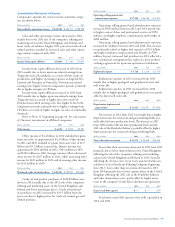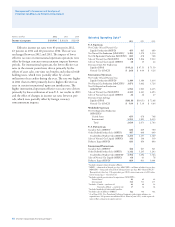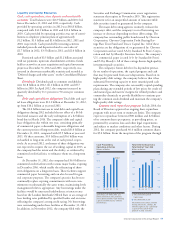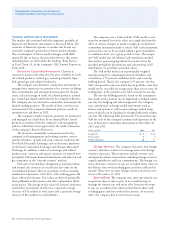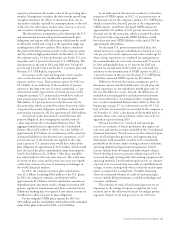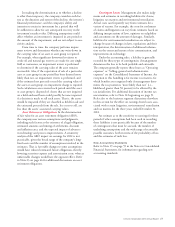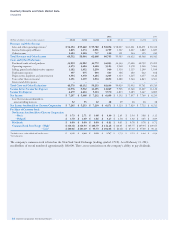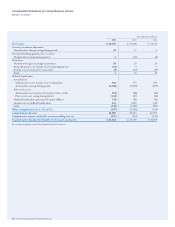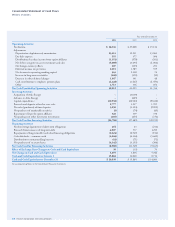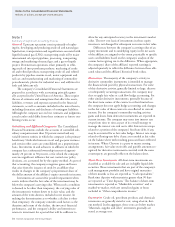Chevron 2012 Annual Report Download - page 28
Download and view the complete annual report
Please find page 28 of the 2012 Chevron annual report below. You can navigate through the pages in the report by either clicking on the pages listed below, or by using the keyword search tool below to find specific information within the annual report.
Management’s Discussion and Analysis of
Financial Condition and Results of Operations
26 Chevron Corporation 2012 Annual Report
Management’s Discussion and Analysis of
Financial Condition and Results of Operations
Consolidated Financial Statements, using the successful
eorts method of accounting, include the following:
1. Amortization - Proved reserves are used in amortiz-
ing capitalized costs related to oil and gas producing
activities on the unit-of-production (UOP) method.
Capitalized exploratory drilling and development
costs are depreciated on a UOP basis using proved
developed reserves. Acquisition costs of proved proper-
ties are amortized on a UOP basis using total proved
reserves. During 2012, Chevron’s UOP Depreciation,
Depletion and Amortization (DD&A) for oil and gas
properties was $10.7 billion, and proved developed
reserves at the beginning of 2012 were 4.8 billion
barrels. If the estimates of proved reserves used in the
UOP calculations for consolidated operations had
been lower by 5 percent across all oil and gas proper-
ties, UOP DD&A in 2012 would have increased by
approximately $540 million.
2. Impairment - Oil and gas reserves are used in assess-
ing oil and gas producing properties for impairment.
A signicant reduction in the estimated reserves of
a property would trigger an impairment review. In
assessing whether the property is impaired, the fair
value of the property must be determined. Frequently,
a discounted cash ow methodology is the best esti-
mate of fair value. Proved reserves (and, in some cases,
a portion of unproved resources) are used to estimate
future production volumes in the cash ow model.
For a further discussion of estimates and assumptions
used in impairment assessments, see Impairment of
Properties, Plant and Equipment and Investments in
Aliates below.
Refer to Table V, “Reserve Quantity Information,” beginning
on page 76, for the changes in proved reserve estimates for
the three years ending December 31, 2012, and to Table VII,
“Changes in the Standardized Measure of Discounted Future
Net Cash Flows From Proved Reserves” on page 84 for esti-
mates of proved reserve values for each of the three years
ended December 31, 2012.
is Oil and Gas Reserves commentary should be read
in conjunction with the Properties, Plant and Equipment
section of Note 1 to the Consolidated Financial Statements,
beginning on page 36, which includes a description of the
“successful eorts” method of accounting for oil and gas
exploration and production activities.
Impairment of Properties, Plant and Equipment and
Investments in Affiliates e company assesses its proper-
ties, plant and equipment (PP&E) for possible impairment
whenever events or changes in circumstances indicate that
the carrying value of the assets may not be recoverable. Such
indicators include changes in the company’s business plans,
changes in commodity prices and, for crude oil and natural
gas properties, signicant downward revisions of estimated
proved reserve quantities. If the carrying value of an asset
exceeds the future undiscounted cash ows expected from
the asset, an impairment charge is recorded for the excess of
carrying value of the asset over its estimated fair value.
Determination as to whether and how much an asset is
impaired involves management estimates on highly uncertain
matters, such as future commodity prices, the eects of ina-
tion and technology improvements on operating expenses,
production proles, and the outlook for global or regional
market supply-and-demand conditions for crude oil, natural
gas, commodity chemicals and rened products. However,
theimpairment reviews and calculations are based on
assumptions that are consistent with the company’s business
plans and long-term investment decisions. Refer also to the
discussion of impairments of properties, plant and equip-
ment in Note 8 beginning on page 41 and to the section on
Properties, Plant and Equipment in Note 1, Summary of Sig-
nicant Accounting Policies, beginning on page 36.
No material individual impairments of PP&E or Invest-
ments were recorded for the three years ending December
31, 2012. A sensitivity analysis of the impact on earnings for
these periods if other assumptions had been used in impair-
ment reviews and impairment calculations is not practicable,
given the broad range of the company’s PP&E and the
number of assumptions involved in the estimates. at is,
favorable changes to some assumptions might have avoided
the need to impair any assets in these periods, whereas unfa-
vorable changes might have caused an additional unknown
number of other assets to become impaired.
Investments in common stock of aliates that are
accounted for under the equity method, as well as invest-
ments in other securities of these equity investees, are
reviewed for impairment when the fair value of the invest-
ment falls below the company’s carrying value. When such a
decline is deemed to be other than temporary, an impairment
charge is recorded to the income statement for the dierence
between the investment’s carrying value and its estimated fair
value at the time.



